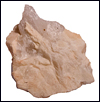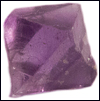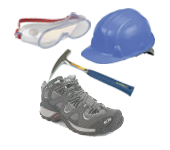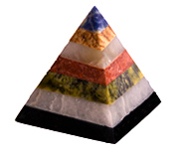Minerals
Minerals are a naturally occurring substances that are solid and stable at room temperature. They are the building blocks of rocks; non-living, solid, and, like all matter, are made of atoms of elements. They are different from a rock, which can be an aggregate of minerals or non-minerals, and does not have a specific chemical composition. There are over 4,900 known mineral species
Below are some of the different types of minerals that I have in my collection along with images. Below this is a table of the properties of the minerals - Mineral Properties
Alabaster
![]() It is a name applied to varieties of two distinct minerals, when used as a material: gypsum and calcite, a carbonate of calcium, also known as onyx-marble, Egyptian alabaster or Oriental alabaster.
It is a name applied to varieties of two distinct minerals, when used as a material: gypsum and calcite, a carbonate of calcium, also known as onyx-marble, Egyptian alabaster or Oriental alabaster.
Calcite
 It is a carbonate mineral and the most stable polymorph of calcium carbonate. Calcite crystals are trigonal-rhombohedral,though actual calcite rhombohedra are rare as natural crystals.
It is a carbonate mineral and the most stable polymorph of calcium carbonate. Calcite crystals are trigonal-rhombohedral,though actual calcite rhombohedra are rare as natural crystals.
 A form of calcite is Dogtooth spar which is a speleothem found in limestone caves that consists of very large calcite crystals resembling dogs' teeth (hence the name). They form through mineral precipitation of water-borne calcite. Dogtooth spar crystals are not limited to caves, but can grow in any open space including veins, fractures and geodes.
A form of calcite is Dogtooth spar which is a speleothem found in limestone caves that consists of very large calcite crystals resembling dogs' teeth (hence the name). They form through mineral precipitation of water-borne calcite. Dogtooth spar crystals are not limited to caves, but can grow in any open space including veins, fractures and geodes.
Gypsum
 It is a very soft sulphate mineral composed of calcium sulphate dehydrate. It can be used as a fertilizer, is the main constituent in many forms of plaster and is widely mined. Gypsum is moderately water-soluble. Gypsum crystals are found to contain anion water and hydrogen bonding.
It is a very soft sulphate mineral composed of calcium sulphate dehydrate. It can be used as a fertilizer, is the main constituent in many forms of plaster and is widely mined. Gypsum is moderately water-soluble. Gypsum crystals are found to contain anion water and hydrogen bonding.
 Desert Rose is a form of Gypsum. A (more or less) rose-like crystal group formed by precipitation in (usually) arid desert regions containing trapped sand particles. Usually Gypsum is the host mineral (Gypsum Rose), but Baryte (Baryte Rose), Celestine and other minerals can form Desert Rose groups, too.
Desert Rose is a form of Gypsum. A (more or less) rose-like crystal group formed by precipitation in (usually) arid desert regions containing trapped sand particles. Usually Gypsum is the host mineral (Gypsum Rose), but Baryte (Baryte Rose), Celestine and other minerals can form Desert Rose groups, too.
Argonite
 It is a carbonate mineral, one of the two common, naturally occurring, crystal forms of calcium carbonate, CaCO3 (the other form being the mineral calcite). It is formed by biological and physical processes, including precipitation from marine and freshwater environments. Aragonite forms naturally in almost all mollusc shells, and as the calcareous endoskeleton of warm- and cold-water corals (Scleractinia). The version I have is called Argonite Sputnik.
It is a carbonate mineral, one of the two common, naturally occurring, crystal forms of calcium carbonate, CaCO3 (the other form being the mineral calcite). It is formed by biological and physical processes, including precipitation from marine and freshwater environments. Aragonite forms naturally in almost all mollusc shells, and as the calcareous endoskeleton of warm- and cold-water corals (Scleractinia). The version I have is called Argonite Sputnik.
Baryte
 It is a mineral consisting of barium sulphate (BaSO4). Baryte itself is generally white or colourless and is the main source of Barium. Baryte occurs in a large number of depositional environments, and is deposited through a large number of processes including biogenic, hydrothermal, and evaporation, among others. Baryte commonly occurs in lead-zinc veins in limestone in hot spring deposits, and with hematite ore. It has also been identified in meteorites.
It is a mineral consisting of barium sulphate (BaSO4). Baryte itself is generally white or colourless and is the main source of Barium. Baryte occurs in a large number of depositional environments, and is deposited through a large number of processes including biogenic, hydrothermal, and evaporation, among others. Baryte commonly occurs in lead-zinc veins in limestone in hot spring deposits, and with hematite ore. It has also been identified in meteorites.
 A form of Baryte is Oakstone, a pseudostalactitic banded variety of crystalline Baryte. Originally reported from Middleton Common, Middleton, Youlgrave, Derbyshire, England, UK.
A form of Baryte is Oakstone, a pseudostalactitic banded variety of crystalline Baryte. Originally reported from Middleton Common, Middleton, Youlgrave, Derbyshire, England, UK.
Beryl
It is a mineral composed of beryllium aluminium cyclosilicate. The hexagonal crystals ofBeryl may be very small or range to several meters in size. Pure Beryl is colourless, but it is frequently tinted by impurities.
 Aquamarine is a blue or turquoise variety of Beryl with Beryllium and aluminium silicate. It occurs at most localities which yield ordinaryBeryl. It is the beautiful gemstone that is the colour of the sea, bluish – green.
Aquamarine is a blue or turquoise variety of Beryl with Beryllium and aluminium silicate. It occurs at most localities which yield ordinaryBeryl. It is the beautiful gemstone that is the colour of the sea, bluish – green.
Bismouth
 It occurs as metallic crystals associated with nickel, cobalt, silver, tin, and uranium sulphide ores. Bismuth is a brittle metal with a white, silver-pink hue, often occurring in its native form, with an iridescent oxide tarnish showing many colours from yellow to blue. The spiral, stair-stepped structure of bismuth crystals is the result of a higher growth rate around the outside edges than on the inside edges. In the Earth's crust, bismuth is about twice as abundant as gold.
It occurs as metallic crystals associated with nickel, cobalt, silver, tin, and uranium sulphide ores. Bismuth is a brittle metal with a white, silver-pink hue, often occurring in its native form, with an iridescent oxide tarnish showing many colours from yellow to blue. The spiral, stair-stepped structure of bismuth crystals is the result of a higher growth rate around the outside edges than on the inside edges. In the Earth's crust, bismuth is about twice as abundant as gold.
Bornite
 It is also known as peacock ore, is a sulfide mineral with chemical composition Cu5FeS4 that crystallizes in the orthorhombic system (pseudo-cubic). Bornite has a brown to copper-red colour on fresh surfaces that tarnishes to various iridescent shades of blue to purple in places.
It is also known as peacock ore, is a sulfide mineral with chemical composition Cu5FeS4 that crystallizes in the orthorhombic system (pseudo-cubic). Bornite has a brown to copper-red colour on fresh surfaces that tarnishes to various iridescent shades of blue to purple in places.
Chalcedony
It is a cryptocrystalline form of silica, composed of very fine intergrowths of the minerals quartz and Magnetite. These are both silica minerals, but they differ in that quartz has a trigonal crystal structure, while Magnetite is monoclinic. Chalcedony occurs in a wide range of varieties. Many semi-precious gemstones are in fact forms of chalcedony. Some of the more notable varieties of chalcedony are Agate, Aventurine, Carnelian and Onyx.
Carnelian is a red, translucent variety of Chalcedony. Its colour, like that of jasper, is due to iron impurities. This translucent stone has a waxy lustre. Its hue may vary from a pale orange, to an intense almost-black coloration.
Copper
 It is a chemical element with the symbol Cu and atomic number 29. It is a ductile metal with very high thermal and electrical conductivity. Copper is essential to all living organisms as a trace dietary mineral because it is a key constituent of a respiratory enzyme. This specimen is from Bingham Canyon Copper Mine, Utah, USA.
It is a chemical element with the symbol Cu and atomic number 29. It is a ductile metal with very high thermal and electrical conductivity. Copper is essential to all living organisms as a trace dietary mineral because it is a key constituent of a respiratory enzyme. This specimen is from Bingham Canyon Copper Mine, Utah, USA.
Feldspars
 They are a group of rock-forming tectosilicate minerals which make up as much as 60% of the Earth's crust. Feldspars crystallize from magma in both intrusive and extrusive igneous rocks, as veins, and are also present in many types of metamorphic rock.
They are a group of rock-forming tectosilicate minerals which make up as much as 60% of the Earth's crust. Feldspars crystallize from magma in both intrusive and extrusive igneous rocks, as veins, and are also present in many types of metamorphic rock.
 Orthoclase is part of the feldspars group. It is an important tectosilicate mineral which forms igneous rocks. The gem known as Moonstone is largely composed of orthoclase.
Orthoclase is part of the feldspars group. It is an important tectosilicate mineral which forms igneous rocks. The gem known as Moonstone is largely composed of orthoclase.
Fluorspar
 This is the original name for Fluorite. Pure fluorspar is colourless, but a variety of impurities give Fluorite a rainbow of different colours, including green, purple, blue, yellow, pink, brown, and black. It has a pronounced cleavage, which means it breaks on flat planes. Fluorite crystals can be well formed, beautiful and highly prized by collectors.
This is the original name for Fluorite. Pure fluorspar is colourless, but a variety of impurities give Fluorite a rainbow of different colours, including green, purple, blue, yellow, pink, brown, and black. It has a pronounced cleavage, which means it breaks on flat planes. Fluorite crystals can be well formed, beautiful and highly prized by collectors.
Garnet
 They are a group of silicate minerals that have been used since the Bronze Age as gemstones and abrasives. Garnets possess similar physical properties and crystal forms, but different chemical compositions. The different species are pyrope, almandine, spessartine, grossular, uvarovite and andradite. Garnet species are found in many colours including red, orange, yellow, green, blue, purple, brown, black, pink and colourless.
They are a group of silicate minerals that have been used since the Bronze Age as gemstones and abrasives. Garnets possess similar physical properties and crystal forms, but different chemical compositions. The different species are pyrope, almandine, spessartine, grossular, uvarovite and andradite. Garnet species are found in many colours including red, orange, yellow, green, blue, purple, brown, black, pink and colourless.
Geodes
![]() They are geological secondary structures which occur in certain sedimentary and volcanic rocks. Geodes are essentially hollow, spherical to oblate masses of mineral matter that may form from either the filling of vesicles(gas bubbles) in volcanic to sub-volcanic rocks by minerals deposited from hydrothermal fluids, or by the dissolution of sedimentary nodules or concretions (that were deposited syngenetically within the rock formations they are found in) and partial filling by the same or other minerals precipitated from diagenetic or hydrothermal fluids.
They are geological secondary structures which occur in certain sedimentary and volcanic rocks. Geodes are essentially hollow, spherical to oblate masses of mineral matter that may form from either the filling of vesicles(gas bubbles) in volcanic to sub-volcanic rocks by minerals deposited from hydrothermal fluids, or by the dissolution of sedimentary nodules or concretions (that were deposited syngenetically within the rock formations they are found in) and partial filling by the same or other minerals precipitated from diagenetic or hydrothermal fluids.
Hematite
 It is iron oxide, Fe2O3. It is the most important iron-ore mineral. Hematite is common in soil and sedimentary rocks, accounting for their reddish colours. Clay-sized hematite crystals can also occur as a secondary mineral formed by weathering processes in soil.
It is iron oxide, Fe2O3. It is the most important iron-ore mineral. Hematite is common in soil and sedimentary rocks, accounting for their reddish colours. Clay-sized hematite crystals can also occur as a secondary mineral formed by weathering processes in soil.
Hornblende
 It is a complex inosilicate series of minerals (ferrohornblende – magnesiohornblende). It is not a recognized mineral in its own right, but the name is used as a general or field term, to refer to a dark amphibole. Hornblende is an isomorphous mixture of three molecules; a calcium-iron-magnesium silicate, an aluminium-iron-magnesium silicate, and an iron-magnesium silicate.
It is a complex inosilicate series of minerals (ferrohornblende – magnesiohornblende). It is not a recognized mineral in its own right, but the name is used as a general or field term, to refer to a dark amphibole. Hornblende is an isomorphous mixture of three molecules; a calcium-iron-magnesium silicate, an aluminium-iron-magnesium silicate, and an iron-magnesium silicate.
Iron Pyrites
 The mineral Pyrite, or Iron Pyrite, is an iron sulphide with the formula FeS2. This mineral's metallic lustre and pale brass-yellow hue have earned it the nickname fool's gold because of its superficial resemblance to gold. The colour has also led to the nicknames brass, brazzle and Brazil, primarily used to refer to Pyrite found in coal.
The mineral Pyrite, or Iron Pyrite, is an iron sulphide with the formula FeS2. This mineral's metallic lustre and pale brass-yellow hue have earned it the nickname fool's gold because of its superficial resemblance to gold. The colour has also led to the nicknames brass, brazzle and Brazil, primarily used to refer to Pyrite found in coal.
Mica
The Mica group of sheet silicate (phyllosilicate) minerals includes several closely related materials having close to perfect basal cleavage. It is a mineral that separates easily into small flat transparent pieces of rock, often used to make electrical instruments. It is easily recognized because of its perfect cleavage that allows it to separate into thin, transparent, flexible sheets.
 A variety of mica is Biotite which is a sheet silicate. Iron, magnesium, aluminium, silicon, oxygen, and hydrogen form sheets that are weakly bound together by potassium ions. Biotite is found in a wide variety of igneous and metamorphic rocks.
A variety of mica is Biotite which is a sheet silicate. Iron, magnesium, aluminium, silicon, oxygen, and hydrogen form sheets that are weakly bound together by potassium ions. Biotite is found in a wide variety of igneous and metamorphic rocks.
 Another type of mica is Muscovite which is the most common mica, found in granites, pegmatites, gneisses, and schists, and as a contact metamorphic rock or as a secondary mineral resulting from the alteration of topaz, feldspar, kyanite, etc.
Another type of mica is Muscovite which is the most common mica, found in granites, pegmatites, gneisses, and schists, and as a contact metamorphic rock or as a secondary mineral resulting from the alteration of topaz, feldspar, kyanite, etc.
Quartz
It is the second most abundant mineral in the Earth's continental crust, after Feldspar. There are many different varieties of Quartz, several of which are semi-precious gemstones.
 A form of quartz is Jasper which belonging to the chalcedony family, is an opaque, impure variety of silica, usually red, yellow, brown or green in colour; and rarely blue. This mineral breaks with a smooth surface, and is used for ornamentation or as a gemstone.
A form of quartz is Jasper which belonging to the chalcedony family, is an opaque, impure variety of silica, usually red, yellow, brown or green in colour; and rarely blue. This mineral breaks with a smooth surface, and is used for ornamentation or as a gemstone.
 Citrine is a variety of quartz whose color ranges from a pale yellow to brown. Natural citrines are rare; most commercial Citrines are heat-treated Amethysts or smoky Quartz
Citrine is a variety of quartz whose color ranges from a pale yellow to brown. Natural citrines are rare; most commercial Citrines are heat-treated Amethysts or smoky Quartz
 Amethyst is a popular form of quartz that ranges from a bright to dark or dull purple color. It owes its violet color to irradiation iron impurities (in some cases in conjunction with transition element impurities), and the presence of trace elements, which result in complex crystal lattice substitutions. It is known as a master healer and is believed to heal all systems of the body.
Amethyst is a popular form of quartz that ranges from a bright to dark or dull purple color. It owes its violet color to irradiation iron impurities (in some cases in conjunction with transition element impurities), and the presence of trace elements, which result in complex crystal lattice substitutions. It is known as a master healer and is believed to heal all systems of the body.
Salt
 It is also known as Table Salt or Rock Salt (Halite), is a crystalline mineral that is composed primarily of sodium chloride. It is absolutely essential for animal life, but can be harmful to animals and plants in excess. Salt is one of the oldest, most ubiquitous food seasonings and salting is an important method of food preservation. The taste of Salt (saltiness) is one of the basic human tastes. Salt Crystals are the solid form of an ionic compound.
It is also known as Table Salt or Rock Salt (Halite), is a crystalline mineral that is composed primarily of sodium chloride. It is absolutely essential for animal life, but can be harmful to animals and plants in excess. Salt is one of the oldest, most ubiquitous food seasonings and salting is an important method of food preservation. The taste of Salt (saltiness) is one of the basic human tastes. Salt Crystals are the solid form of an ionic compound.
Sodalite
![]() It is a member of the sodalite group with hauyne, nosean, lazurite and tugtupite. Sodalite is a rich royal blue mineral widely enjoyed as an ornamental gemstone. Although massive sodalite samples are opaque, crystals are usually transparent to translucent.
It is a member of the sodalite group with hauyne, nosean, lazurite and tugtupite. Sodalite is a rich royal blue mineral widely enjoyed as an ornamental gemstone. Although massive sodalite samples are opaque, crystals are usually transparent to translucent.
Sulphur
 It occurs as the free element near volcanoes and hot springs. Many sulphide minerals are known and sulphur is widely distributed in minerals such as Iron Pyrites, Galena, Sphalerite, Cinnabar, Stibnite, Gypsum, Epsom salts, Celestite, and Barite. Sulphur occurs in natural gas and crude oil. It is also present in meteorites.
It occurs as the free element near volcanoes and hot springs. Many sulphide minerals are known and sulphur is widely distributed in minerals such as Iron Pyrites, Galena, Sphalerite, Cinnabar, Stibnite, Gypsum, Epsom salts, Celestite, and Barite. Sulphur occurs in natural gas and crude oil. It is also present in meteorites.
Turquentite
![]() The original definition of 'Turquenite', as used in lapidary and mineral trade since the 1970s is as an artificially-coloured blue variety of Howlite or Magnesite dyed to resemble Turquoise and sold as a (fake) gemstone, often as tumbled stones. It is not suitable for carving (usually) as the dye does not often penetrate deep into the stone. Howlite, a calcium borosilicate hydroxide, is a borate mineral found in evaporite deposits.
The original definition of 'Turquenite', as used in lapidary and mineral trade since the 1970s is as an artificially-coloured blue variety of Howlite or Magnesite dyed to resemble Turquoise and sold as a (fake) gemstone, often as tumbled stones. It is not suitable for carving (usually) as the dye does not often penetrate deep into the stone. Howlite, a calcium borosilicate hydroxide, is a borate mineral found in evaporite deposits.
Zeolite
 These are a group of similar-looking minerals that form at shallow depths and relatively low temperatures, less than 200°C. Zeolites are useful because of their molecular structure: like quartz they are framework silicates, but the silica units are widely separated, with the spaces between occupied by water molecules and common cations, mostly sodium and calcium. The Zeolite I have is called Stilbite, which comes in colours from white to red to brown.
These are a group of similar-looking minerals that form at shallow depths and relatively low temperatures, less than 200°C. Zeolites are useful because of their molecular structure: like quartz they are framework silicates, but the silica units are widely separated, with the spaces between occupied by water molecules and common cations, mostly sodium and calcium. The Zeolite I have is called Stilbite, which comes in colours from white to red to brown.
| Minerals | Specific Gravity | Hardness (Moh's scale) | Cleavage | Fracture |
|---|---|---|---|---|
| {Minerals} | {Specific_Gravity} | {Hardness} | {Cleavage} | {Fracture} |

